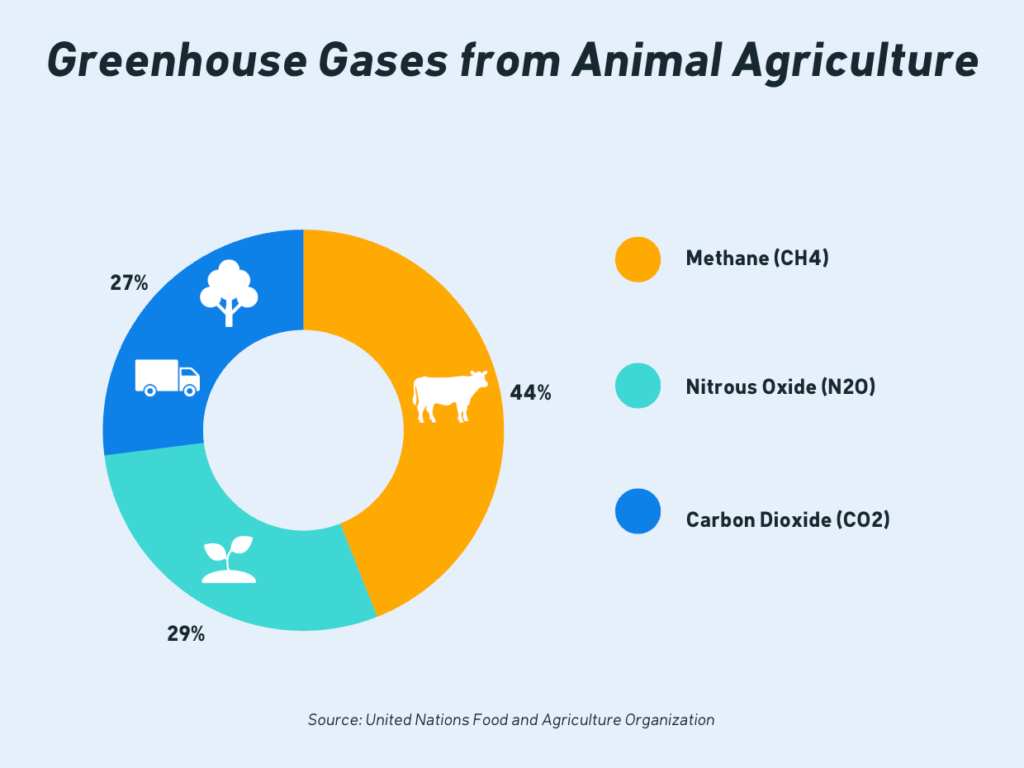By Abby Crowley, Plant-Forward Team Lead
We know that we’re in the midst of a global climate crisis, and that climate change is caused by human activity – namely the rise of greenhouse gas(GHG) emissions primarily due to the burning of fossil fuels. We tend to associate this rise of GHG emissions with the burning of fossil fuels for energy, as well as transportation. But there are many other industries and activities that contribute to this. What if I were to tell you that one of these activities is right under your nose – or should I say, on your plate.

My name is Abby, and I’m the team leader of SD350’s new Plant-Forward. What motivates me to be plant based is knowing that each day I get to choose to do something that makes a positive difference and helps to combat climate change.
One of the major drivers of climate change is animal agriculture (raising animals for food) – it accounts for an estimated 15% of global GHG emissions– greater than all transportation combined. Of all the greenhouse gas emissions from animal agriculture, 44% is methane (CH4), 29% is nitrous oxide (N2O), and 27% is carbon dioxide (CO2). But where do these emissions come from?
Carbon dioxide emissions related to animal agriculture come from land use change, producing fertilizers and pesticides used on feed crops, electricity use on farms and in slaughterhouses, burning fossil fuels to create farm equipment, the transportation associated with animal agriculture, and more. Animal agriculture is the number one cause of deforestation worldwide and second largest contributor to man-made greenhouse gas emissions. Land use change is characterized in this context by the massive deforestation required to create pastures to graze cattle and fields to grow their feed crops (mainly monocrops of soy which present another set of environmental issues). Cutting down forests produces Carbon Dioxide, a greenhouse gas that those forests previously absorbed. Transportation involved in the production process ranges from transporting feed, animals, fertilizers and pesticides, and end food products.
Nitrous oxide from animal agriculture comes from soil, wastewater treatment from processing meat & poultry, and pig & poultry manure. N2O emissions from soil are exacerbated by chemical fertilizers used to grow feed crops. Animal agriculture accounts for 65% of the world’s nitrous oxide emissions. Nitrous oxide has a global warming potential that is 296x higher than carbon dioxide. Manure just got a whole lot stinkier!

Methane is perhaps the worst – it’s 30x more potent than CO2, and it comes from cattle and other ruminant livestock. Ruminant animals are sheep, goats, and primarily cattle. There are two ways in which these animals produce methane, from their manure and from their unique digestion. These animals produce enteric emissions – a fancy way to say burps and farts. It’s important to note that the animals used for animal agriculture are innocent victims who are not to blame. They aren’t the problem, we are – the mass demand and consumption of animal products has led to the current system of mass production. Methane released due to enteric emissions from cattle alone account for 45% of agriculture emissions in the U.S, and 4.5% of all GHG emissions in the US.
On the brightside:
With each plant-based meal you eat you can save more than 100 kg of greenhouse gases, and switching to a plant-based diet can reduce your carbon footprint by up to 2.1 tons per year! According to researchers at Stanford University, if everyone in the U.S. went just one day a week without eating meat and dairy, the environmental impact would be equivalent to taking 7.6 million cars off the road.
How can you help?
- Start by eating more plant-based, meaning reducing meat & dairy consumption, switching to plant-based alternatives, and getting more of your protein from plants, like beans, nuts, seeds, tofu, tempeh, and plant-based meat alternatives. If you’re curious about how you can help reduce emissions through your food choices, check out Harvard University’s FoodPrint Calculator
- Share this blog post with friends and family.
- Check out SanDiego350’s newest team, Plant Forward! The team’s goal is to help the San Diego community reduce emissions and other environmental impacts associated with animal agriculture by educating about and promoting a plant-based diet, as well as advocating for policies that promote the reduction of animal-based products. Read the team’s Crash Course Document to learn more about what they are doing.
